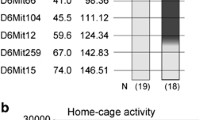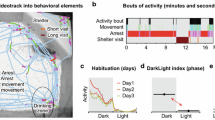Abstract
Performance in the open field and rotarod paradigms, two common assessments of locomotor function, have been demonstrated to be strain dependent in mice. In this study, eight significant quantitative trait loci (QTL) for behavior phenotypes in either the open field or rotarod paradigms were identified between the 129S6 (129/SvEvTac) and C57BL/6J strains. These strains were chosen for comparison because of their frequent use in the generation of mutant mice from gene-targeted, embryonic stem cells. Two of the QTLs for horizontal distance traveled are located on Chromosomes (Chrs) 1 and 12 and closely replicate the findings of other groups using different strains of mice. Rotarod performance was influenced in an oppositional manner by two separate QTLs on Chr 1 and 2. Additionally, examination of several different aspects of behavior in the open field revealed significant QTLs for average speed (Chr 12), duration (Chrs 2, 16, and 18), time spent in motion (Chr 16), vertical movements (rearing) (Chrs 6 and 12), and vertical time (rearing time) (Chrs 6 and 12). Our finding of independent QTLs for these topographic components of open field activity supports the idea that they are separate and distinct from total horizontal distance traveled and should be studied independently. The QTLs described in this study, in combination with our panel of polymorphic chromosomal markers for 129S6 and C57BL/6J strains, will be useful in assessing the potential epistatic effects of parental strain background on the phenotypes of genetically modified mice.



Similar content being viewed by others
References
JH Baik R Picetti A Saiardi G Thiriet A Dierich et al. (1995) ArticleTitleParkinsonian-like locomotor impairment in mice lacking dopamine D2 receptors. Nature 377 424–428 Occurrence Handle1:STN:280:BymD3cflsVc%3D Occurrence Handle7566118
V Bolivar M Cook L Flaherty (2000) ArticleTitleList of transgenic and knockout mice: behavioral profiles. Mamm Genome 11 260–274 Occurrence Handle10.1007/s003350010051 Occurrence Handle1:CAS:528:DC%2BD3cXis12jt78%3D Occurrence Handle10754101
VJ Bolivar MN Cook L Flaherty (2001) ArticleTitleMapping of quantitative trait loci with knockout/congenic strains. Genome Res 11 1549–1552 Occurrence Handle1:CAS:528:DC%2BD3MXmvV2mtrY%3D Occurrence Handle11544198
GA Churchill RW Doerge (1994) ArticleTitleEmpirical threshold values for quantitative trait mapping. Genetics 138 963–971 Occurrence Handle1:STN:280:ByqC2MvntFw%3D Occurrence Handle7851788
Y Clement B Martin P Venault G Chapouthier (1995) ArticleTitleInvolvement of regions of the 4th and 7th chromosomes in the open-field activity of mice. Behav Brain Res 70 51–57 Occurrence Handle1:STN:280:BymD2M7hs1I%3D Occurrence Handle8519428
C Contet JN Rawlins RM Deacon (2001) ArticleTitleA comparison of 129S2/SvHsd and C57BL/6JOlaHsd mice on a test battery assessing sensorimotor, affective and cognitive behaviours: implications for the study of genetically modified mice. Behav Brain Res 124 33–46 Occurrence Handle1:STN:280:DC%2BD38%2Fhs1Gmsg%3D%3D Occurrence Handle11423164
JN Crawley JK Belknap A Collins JC Crabbe W Frankel et al. (1997) ArticleTitleBehavioral phenotypes of inbred mouse strains: implications and recommendations for molecular studies. Psychopharmacology 132 107–124 Occurrence Handle1:CAS:528:DyaK2sXlt1WntLc%3D Occurrence Handle9266608
RW Doerge GA Churchill (1996) ArticleTitlePermutation tests for multiple loci affecting a quantitative character. Genetics 142 285–294 Occurrence Handle1:STN:280:BymA28nkt1w%3D Occurrence Handle8770605
GA Elder VL Jr Friedrich K Chu RA Lazzarini (2000) ArticleTitlePresence of unmyelinated axons in the lumbar ventral roots of the 129 mouse strain. Neurosci Lett 287 101–104 Occurrence Handle1:CAS:528:DC%2BD3cXktVSnsbk%3D Occurrence Handle10854722
A Fernandez-Teruel RM Escorihuela JA Gray R Aguilar L Gil et al. (2002) ArticleTitleA quantitative trait locus influencing anxiety in the laboratory rat. Genome Res 12 618–626 Occurrence Handle1:CAS:528:DC%2BD38XivVemt7Y%3D Occurrence Handle11932246
MF Festing EM Simpson MT Davisson LE Mobraaten (1999) ArticleTitleRevised nomenclature for strain 129 mice. Mamm Genome 10 836 Occurrence Handle1:STN:280:DyaK1MzlvFynug%3D%3D Occurrence Handle10430671
J Flint R Corley JC DeFries DW Fulker JA Gray et al. (1995) ArticleTitleA simple genetic basis for a complex psychological trait in laboratory mice. Science 269 1432–1435 Occurrence Handle1:CAS:528:DyaK2MXnvFCkt70%3D Occurrence Handle7660127
R Gerlai (1996) ArticleTitleGene-targeting studies of mammalian behavior: is it the mutation or the background genotype? Trends Neurosci 19 177–181 Occurrence Handle1:CAS:528:DyaK28Xislagsr0%3D Occurrence Handle8723200
HK Gershenfeld PE Neumann C Mathis JN Crawley X Li et al. (1997) ArticleTitleMapping quantitative trait loci for open-field behavior in mice. Behav Genet 27 201–210 Occurrence Handle1:STN:280:ByiA2Mvlt1E%3D Occurrence Handle9210791
CS Hall (1934) ArticleTitleEmotional behavior in the rat: I. Defecation and urination as measures of individual differences in emotionality. J Comp Psychol 18 385–403
CS Hall EL Ballachey (1932) ArticleTitleA study of the rat’s behavior in a field: a contribution to method in comparative psychology. Univ Calif Publ Psychol 6 1–12
GE Homanics JJ Quinlan LLv Firestone (1999) ArticleTitlePharmacologic and behavioral responses of inbred C57BL/6J and strain 129/SvJ mouse lines. Pharmacol Biochem Behav 63 21–26 Occurrence Handle10.1016/S0091-3057(98)00232-9 Occurrence Handle1:CAS:528:DyaK1MXjtFSmurY%3D Occurrence Handle10340519
MA Kelly M Rubinstein SL Asa G Zhang C Saez et al. (1997) ArticleTitlePituitary lactotroph hyperplasia and chronic hyperprolactinemia in dopamine D2 receptor-deficient mice. Neuron 19 103–113 Occurrence Handle1:CAS:528:DyaK2sXltFCjsrY%3D Occurrence Handle9247267
MA Kelly M Rubinstein TJ Phillips CN Lessov S Burkhart-Kasch et al. (1998) ArticleTitleLocomotor activity in D2 dopamine receptor-deficient mice is determined by gene dosage, genetic background, and developmental adaptations. J Neurosci 18 3470–3479 Occurrence Handle1:CAS:528:DyaK1cXivFCms7o%3D Occurrence Handle9547254
E Lander L Kruglyak (1995) ArticleTitleGenetic dissection of complex traits: guidelines for interpreting and reporting linkage results. Nat Genet 11 241–247 Occurrence Handle1:CAS:528:DyaK2MXptlSjs74%3D Occurrence Handle7581446
ES Lander P Green J Abrahamson A Barlow MJ Daly et al. (1987) ArticleTitleMAPMAKER: an interactive computer package for constructing primary genetic linkage maps of experimental and natural populations. Genomics 1 174–181 Occurrence Handle1:CAS:528:DyaL1cXhsVCksrk%3D Occurrence Handle3692487
KF Manly JH Cudmore Jr JM Meer (2001) ArticleTitleMap Manager QTX, cross-platform software for genetic mapping. Mamm Genome 12 930–932 Occurrence Handle1:CAS:528:DC%2BD3MXosFGgtbo%3D Occurrence Handle11707780
GE McClearn (1960) ArticleTitleStrain differences in activity of mice: influence of illumination. J Comp Physio Psychol 53 142–143
A Montkowski M Poettig A Mederer F Holsboer (1997) ArticleTitleBehavioral performance in three substrains of mouse strain 129. Brain Res 762 12–18 Occurrence Handle1:CAS:528:DyaK2sXkt1SqsLk%3D Occurrence Handle9262153
MP Paulus SC Dulawa RJ Ralph MA Geyer (1999) ArticleTitleBehavioral organization is independent of locomotor activity in 129 and C57 mouse strains. Brain Res 835 27–36 Occurrence Handle1:CAS:528:DyaK1MXlt1Omsrs%3D Occurrence Handle10448193
JA Sanchez CS Ho DM Vaughan MC Garcia RW Grange et al. (2000) ArticleTitleMuscle and motor-skill dysfunction in a K+ channel-deficient mouse are not due to altered muscle excitability or fiber type but depend on the genetic background. Pflueg Arch Eur J Physiol 440 34–41 Occurrence Handle1:CAS:528:DC%2BD3cXjsFKisbw%3D
S Sen G Churchill (2001) ArticleTitleA statistical framework for quantitative trait mapping. Genetics 159 371–387 Occurrence Handle1:STN:280:DC%2BD3MrhtlShsA%3D%3D Occurrence Handle11560912
EM Simpson CC Linder EE Sargent MT Davisson LE Mobraaten et al. (1997) ArticleTitleGenetic variation among 129 substrains and its importance for targeted mutagenesis in mice. Nat Genet 16 19–27 Occurrence Handle1:CAS:528:DyaK2sXivFKhsLg%3D Occurrence Handle9140391
WR Thompson (1953) ArticleTitleThe inheritance of behavior: behavioral differences in fifteen mouse strains. Can J Psychol 7 145–155 Occurrence Handle13116066
WR Thompson (1956) ArticleTitleThe inheritance of behavior: activity differences in five inbred mouse strains. J Hered 47 147–148
RN Walsh RA Cummins (1976) ArticleTitleThe open-field test: a critical review. Psychol Bull 83 482–504 Occurrence Handle10.1037//0033-2909.83.3.482
DP Wolfer U Muller M Stagliar HP Lipp (1997) ArticleTitleAssessing the effects of the 129/Sv genetic background on swimming navigation learning in transgenic mutants: a study using mice with a modified beta-amyloid precursor protein gene. Brain Res 771 1–13 Occurrence Handle1:CAS:528:DyaK2sXmtFKgsLY%3D Occurrence Handle9383002
DP Wolfer WE Crusio HP Lipp (2002) ArticleTitleKnockout mice: simple solutions to the problems of genetic background and flanking genes. Trends Neurosci 25 336–340 Occurrence Handle1:CAS:528:DC%2BD38XksFKrsb4%3D Occurrence Handle12079755
KH You CL Hsieh C Hayes N Stahl U Francke et al. (1991) ArticleTitleDNA sequence, genomic organization, and chromosomal localization of the mouse peripheramyelin protein zero gene: identification of polymorphic alleles. Genomics 9 751–757 Occurrence Handle1:CAS:528:DyaK38Xhs1Ont70%3D Occurrence Handle1709914
Acknowledgements
The authors thank the following institutions for support: Department of Veterans Affairs (T.J. Phillips), NIDA R01 grant DA10913 (T.J. Phillips), NIAAA Alcohol Center grant AA10760 (T.J. Phillips), NIDA training grant T32 DA07262 (M.A. Kelly), NIDDK training grant T32DK07257 (M.A. Kelly), and funding from ERATO/JST (M. Yanagisawa). M. Yanagisawa is an Investigator and M.A. Kelly is an Associate of the Howard Hughes Medical Insitute.
Author information
Authors and Affiliations
Corresponding author
Rights and permissions
About this article
Cite this article
Kelly, M.A., Low, M.J., Phillips, T.J. et al. The mapping of quantitative trait loci underlying strain differences in locomotor activity between 129S6 and C57BL/6J mice . Mamm Genome 14, 692–702 (2003). https://doi.org/10.1007/s00335-003-2273-0
Received:
Accepted:
Issue Date:
DOI: https://doi.org/10.1007/s00335-003-2273-0




